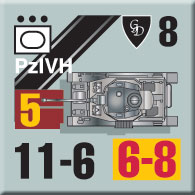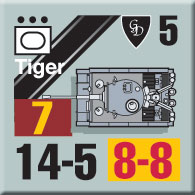Grossdeutschland 1944:
Scenario Preview, Part Three
by Mike Bennighof, Ph.D.
April 2025
 While I know my career path in game design has been a disappointment to my doktormutter, every now and then it gives me a satisfaction that I never got out of academic history. Panzer Grenadier: Grossdeutschland 1944, despite the bombastic title, was one of those. I got to tell a story, a pretty detailed story, in game format. It’ll never get me tenure, but I was never going to get tenure anyway, and at least I got to make something people are going to enjoy. While I know my career path in game design has been a disappointment to my doktormutter, every now and then it gives me a satisfaction that I never got out of academic history. Panzer Grenadier: Grossdeutschland 1944, despite the bombastic title, was one of those. I got to tell a story, a pretty detailed story, in game format. It’ll never get me tenure, but I was never going to get tenure anyway, and at least I got to make something people are going to enjoy.
So let’s have a look at Chapter Three of Grossdeutschland 1944. In this chapter the Soviet 37th Army renews its attack across the Dnestr to widen the breach it made on the first day of the offensive and finish smashing up the Axis defenders.
Scenario Twelve
Up on Căuşeni Hill
21 August 1944
When the sun rose, the Soviets renewed their efforts to capture the key height at Căuşeni Hill. It overlooked all of the territory on the right bank of the Dnestr, allowing observers there to call down artillery fire on the Soviet supply lines and approaching reinforcements.
Conclusion
As 37th Army’s command had feared, the Germans had rushed two regiments from 384th Infantry Division overnight by truck to the hill. Bunkers and trenches had been prepared there during the preceding months, and the Soviets suddenly faced a well-ordered defense manned by fresh troops. Amid what the Soviet General Staff study described as “fierce fighting,” the Red riflemen took the hill at the cost of heavy casualties and with the aid of heavy tanks and heavy artillery and air support. The Germans were not yet ready to give up such an important position.
Notes
This is a big scenario, a tank-supported attack by Guards infantry against prepared German defenses atop a pretty nasty hill. The Soviets have lots of artillery to plaster the fortifications, plus airplanes. One of the advantages of the expansion-book format of which I’ve tried to take advantage is the ability to craft really big scenarios that wouldn’t be possible in the standard games (because we couldn’t cram enough pieces in them, and if we tell players to take more pieces from another game they set their heads on fire).
Scenario Thirteen
Counter Attack at Căuşeni Hill
21 August 1944
 Thirteenth Panzer Division reported that it attacked the Soviet spearheads on the offensive’s first day and suffered a repulse; Soviet accounts say that the division tried to fill the breach between the German 306th Infantry and Romanian 4th Mountain Divisions but did not attack. All agree that 13th Panzer Division attempted to attack the oncoming Soviets on the next morning. Thirteenth Panzer Division reported that it attacked the Soviet spearheads on the offensive’s first day and suffered a repulse; Soviet accounts say that the division tried to fill the breach between the German 306th Infantry and Romanian 4th Mountain Divisions but did not attack. All agree that 13th Panzer Division attempted to attack the oncoming Soviets on the next morning.
Conclusion
According to the Soviet General Staff study, the Soviets captured the hill in an early morning attack, repulsed the German panzer division’s late-morning attack, and then captured the hill in an afternoon attack. It appears that the panzers succeeded in capturing at least part of the hill, the Soviets ejected them again, and then drove them off the hill in a third separate attack by a mechanized brigade.
Notes
This time it’s the panzers on the attack, against a foe they might be able to push around - an RKKA rifle division without tank support, but they do have a sufficiency of anti-tank guns. The Soviets are the ones with the good position this time, but even in the last year of the war a badly-depleted panzer division remains a potent offensive force.
Scenario Fourteen
Panzer Defense on Căuşeni Hill
21 August 1944
 The Soviet plan had called for 37th Army’s armored reserve to enter the front lines at dawn of the offensive’s second day. Delays brought the tanks to the front only in the afternoon, and when they went forward 16th Mechanized Brigade encountered German troops still stubbornly clinging to Căuşeni Hill. The Soviet plan had called for 37th Army’s armored reserve to enter the front lines at dawn of the offensive’s second day. Delays brought the tanks to the front only in the afternoon, and when they went forward 16th Mechanized Brigade encountered German troops still stubbornly clinging to Căuşeni Hill.
Conclusion
The German 13th Panzer Division had assumed responsibility for Căuşeni Hill, and its anti-tank defenses held out against repeated Soviet tank attacks for most of the day. They finally withdrew in the afternoon, leaving behind eight damaged anti-tank guns, but they had prevented the Soviet mechanized corps from making any gains in its first day of exploitation. Comrade Stalin sent a personal note demanding better results on the following day.
Notes
Soviet tanks are trying to fight their way uphill against a pretty stout German defense of anti-tank guns and assault guns covered by infantry. The tankmen probably should have gone around the hill and left it to the riflemen, and that’s likely what 37th Army intended, but here they are.
Scenario Fifteen
Chaha Crossings
22 August 1944
 The shallow Chaha River wasn’t much of a defensive barrier, but it did present a convenient objective line on 37th Army’s situation maps. Army commander Lt. Gen Mikhail Sharokhin insisted that the slow-moving 7th Mechanized Corps make up for the previous day’s somnolence by clearing all Axis troops from the left bank of the Cogîlnic’s tributary and pressed its 16th Mechanized Brigade forward. The Germans had rushed fresh reinforcements to the scene, hoping to hold back the red wave. The shallow Chaha River wasn’t much of a defensive barrier, but it did present a convenient objective line on 37th Army’s situation maps. Army commander Lt. Gen Mikhail Sharokhin insisted that the slow-moving 7th Mechanized Corps make up for the previous day’s somnolence by clearing all Axis troops from the left bank of the Cogîlnic’s tributary and pressed its 16th Mechanized Brigade forward. The Germans had rushed fresh reinforcements to the scene, hoping to hold back the red wave.
Conclusion
Making up for their failures on the previous day, 16th Mechanized Brigade met all of their objectives. The Germans were swept back over the Chaha and 37th Army now had secure bridgeheads over the river. The German position was rapidly crumbling and even fresh reinforcements like 302nd Infantry Division couldn’t make a difference. Only armored divisions could make a difference, and those had left the theater weeks before.
Notes
This is a different sort of scenario, with the Soviets moving along the river trying to toss the Germans off their side. The Germans actually have a respectable force with good support, but the Soviets are totally mobile and have plenty of tanks. But the demands on the Soviet player are pretty intensive, so there’s not much time to wait around crushing the Germans with sheer force of numbers.
Scenario Sixteen
Expensive Education
23 August 1944
 Desperate to close the breach in their lines, the German Sixth Army flung all of its reserves into an effort to build a new defense along the Cogîlnic River, designated the Stefan Line. At Abaclia the 153rd Training Division found that the Soviets were somehow already over the river, and immediately attacked in an effort to push them back to the other side. Desperate to close the breach in their lines, the German Sixth Army flung all of its reserves into an effort to build a new defense along the Cogîlnic River, designated the Stefan Line. At Abaclia the 153rd Training Division found that the Soviets were somehow already over the river, and immediately attacked in an effort to push them back to the other side.
Conclusion
Seventh Mechanized Corps was not a particularly good unit, but it was good enough to crush the German assault on their bridgehead. The German attempt to build a new defense in the Stefan Line failed before it could even begin, and the Sixth Army began streaming westwards in an attempt to avoid encirclement. They would not be escaping across the bridge at Abaclia.
Notes
The German training division has a lot of heavy weapons - part of the whole training mission - but other than that, they’re really bad except for the attached assault gun brigade. They can’t win without attacking, but at least the Soviets aren’t a whole lot better at this fighting thing and the assault guns outnumber the Soviet tanks on hand here.
And that’s Chapter Three. Next time, we’ll wrap it up with the fourth and final chapter.
You can order Grossdeutschland 1944 right here.
Red Storm Package
Broken Axis
Grossdeutschland 1944
Eastern Front Artillery
Retail Price: $139.97
Package Price: $110.00
Gold Club Price: $88.00
You can order the Red Storm Package right here.
Please allow an extra three weeks for delivery.
Sign up for our newsletter right here. Your info will never be sold or transferred; we'll just use it to update you on new games and new offers.
Mike Bennighof is president of Avalanche Press and holds a doctorate in history from Emory University. A Fulbright Scholar and NASA Journalist in Space finalist, he has published an unknowable number of books, games and articles on historical subjects.
He lives in Birmingham, Alabama with his wife and three children. He will never forget his dog, Leopold.
Want to keep Daily Content free of third-party ads? You can send us some love (and cash) through this link right here.
|
